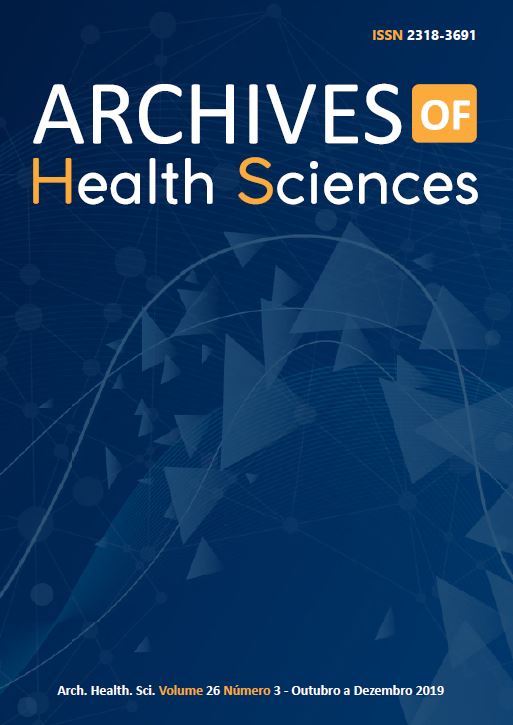Clinical and surgical epidemiological analysis after bilateral herniorrhaphy
DOI:
https://doi.org/10.17696/2318-3691.26.3.2019.1275Keywords:
Hernia; Herniorrhaphy; Hernia, Inguinal; General Surgery; EpidemiologyAbstract
Introduction: Inguinal hernia is an anatomical defect resulting from evagination of intra-abdominal structures into inguinal canal. In bilateral cases, the surgical approach depends on the extent of the hernia and may be associated with greater relapse rate than that of unilateral repair. Objective: To analyze clinical and surgical epidemiological variables in the postoperative period of patients submitted to bilateral inguinal herniorrhaphy. Methods: Retrospective study of 51 medical records of patients submitted to bilateral inguinal herniorrhaphy at Hospital Estadual João Paulo II de São José do Rio Preto (SP) from 2006 to 2016. Results: Patients had mean age of 51.6 years, were most male (84%), whites (86.36%), smokers (62.86%), and farmers (21.43%). In 100% of cases, spinal anesthesia and use of tension-free technique (Lichtenstein) were performed, with in-hospital stay ranging from 1 to 4 days. During an average of 4 years of postoperative follow-up, there were no complications in 43 patients (84.31%); unilateral relapse occurred in 7.84%, and seroma in 3.92%. Average time to return to post-surgery activities was 58 days. There was significant association between inguinal hernia and male gender, Caucasian race, occupation as farmer and smoking; but no associations with periods of hospitalization, return to daily activities and postoperative follow-up. Conclusion: Bilateral inguinal hernia tends to affect white middle-aged men, smokers and with intense physical labor. Spinal anesthesia and surgical technique of Lichtenstein have been widely accepted as treatment approach. Although unilateral relapse may be present, it is associated with intrinsic factors or surgical intercurrences. Bilateral repair of inguinal hernia presents no morbidity greater than unilateral correction, and return to daily activities tends to be similar.
References
Glassow F. The Shouldice Hospital technique. Int Surg. 1986;71(3):148-53.
Hernia Center [homepage na Internet]. [acesso em 2018 Maio 16]. Hérnia inguinal do trabalhador. Diretrizes que gerenciam o fluxo do trabalhador com hérnia inguinal na direção do tratamento que rapidamente permite sua plena reintegração na atividade laborativa; [aproximadamente 9 telas]. Disponível em: https://herniacenter.com.br/arquivos/protocolo_trabalhador.pdf.
Maciel GSB, Simões RL, Carmo FPT, Garcia JWR, Paulo DNS. Resultados da herniorrafia inguinal bilateral simultânea pela técnica de Lichtenstein. Rev Col Bras Cir. 2013;40(5):370-3.
Sperandio WT, Queroz T, Soares RP, Kelmann G, Bernardo WM. Quais os fatores de risco para hérnia inguinal em adulto? Rev Assoc Méd Bras. 2008;54(2):98. http://dx.doi.org/10.1590/S0104-42302008000200004
Goulart A, Martins S. Hérnia Inguinal: anatomia, patofisiologia, diagnóstico e tratamento. Rev Port Cirur. 2015;(33):25-42.
Bax T, Sheppard BC, Crass RA. Surgical options in the management of groin hernias. Am Fam Physician. 1999;59(4):893-906.
Mello DACPG, Furtado WS, Santos VM, Schroff WLA, Oliveira Junior WP. Retorno ao trabalho após herniorrafia inguinal convencional com prótese e sem prótese, por videolaparoscopia. Brasília Méd. 2014;50(3):221-7.
Van Hessen CV, Burgmans JPJ, Verleisdonk EJMM. Inguinal hernia repair: bringing order to variety. Ned Tijdschr Geneeskd. 2018;162:D2216.
Sun J, Wang W, Li J, Yue F, Feng B, Wang J, et al. Laparoscopic experience for recurrent inguinal hernia repair in a single center for 14 years. Am Surg. 2018;84(3):344-350.
Pedroso LM, Melo RM, Silva Junior NJ. Comparative study of postoperative pain between the Lichtenstein and laparoscopy surgical techniques for the treatment of unilateral primary inguinal hernia. Arq Bras Cir Dig. 2017;30(3):173-6. http://dx.doi.org/10.1590/0102-6720201700030003
Falci F. Marlex-mesh no tratamento da hérnia inguinal do adulto (análise de 100 casos operados). Hospital. 1969;75(1):147-59.
Campanelli G, Bruni PG, Morlacchi A, Lombardo F, Cavalli M. Primary inguinal hernia: the open repair today pros and cons. Asian J Endosc Surg. 2017;10(3):236-43. doi: 10.1111/ases.12394
Melchor González JM, Pérez García R, Argumedo Villa M, Domínguez Garciadiego F. Reparación de la hernia inguinal sin tensión. Cir Ciruj. 2000;68(2):68-71.
Meco BC, Bermede O, Vural C, Cakmak A, Alanoglu Z, Alkis N. A comparison of two different doses of morphine added to spinal bupivacaine for inguinal hernia repair. Braz J Anesthesiol. 2016;66(2):140-4. http://dx.doi.org/10.1016/j.bjane.2014.08.002
Claus CMP, Rocha GM, Campos ACL, Paulin JAN, Coelho JCU. Mesh displacement after bilateral inguinal hernia repair with no fixation. JSLS. 2017;21(3):e2017.00033. doi: 10.4293/JSLS.2017.00033
Geiger S, Bobylev A, Schädelin S, Mayr J, Holland-Cunz S, Zimmermann P. Single-center, retrospective study of the outcome of laparoscopic inguinal herniorrhaphy in children. Medicine (Baltimore). 2017;96(52):e9486. doi: 10.1097/MD.0000000000009486
Zarroug AE, Alkhebel AM, Gibreel WO, Almassry M. A new, simple operative approach for bilateral inguinal hernia repair in girls: A single transverse supra-pubic incision. J Indian Assoc Pediatr Surg. 2015;20(4):170-3. doi: 10.4103/0971-9261.154649
Gopal SV, Warrier A. Recurrence after groin hernia repair-revisited. Int J Surg. 2013;11(5):374-7. doi: 10.1016/j.ijsu.2013.03.012
Downloads
Published
Issue
Section
License

This work is licensed under a Creative Commons Attribution-NonCommercial-NoDerivatives 4.0 International License.










